Shiitake Inoculation Parties.
Forest Voges and I have been hosting community Shiitake Inoculation parties every Fall and Spring for the last few years. We usually hold them behind Forest’s house at 206 Cooleyville Rd, Shutesbury, MA 01072.
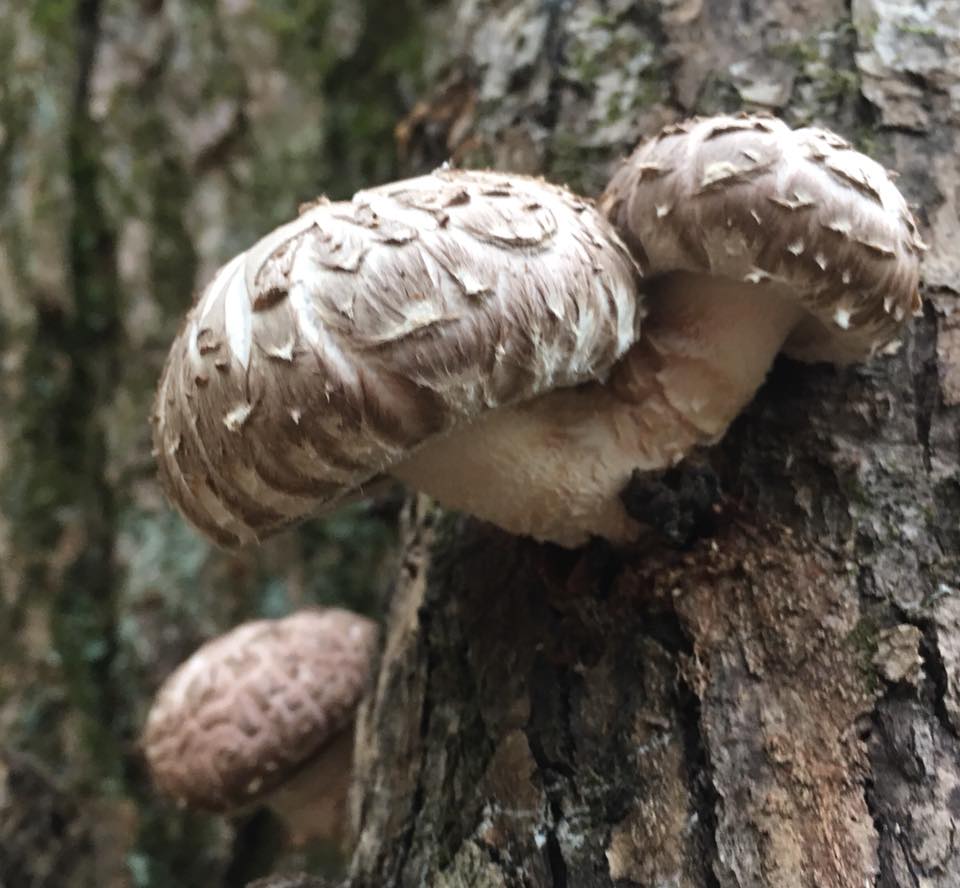
We supply materials, tools, and some assembly line systems to help the work move smoothly. We also have been cutting and collecting logs for inoculation.
Forest’s Landrover filled with Red Oak logs for inoculation after collecting what we
earlier cut in the woods.
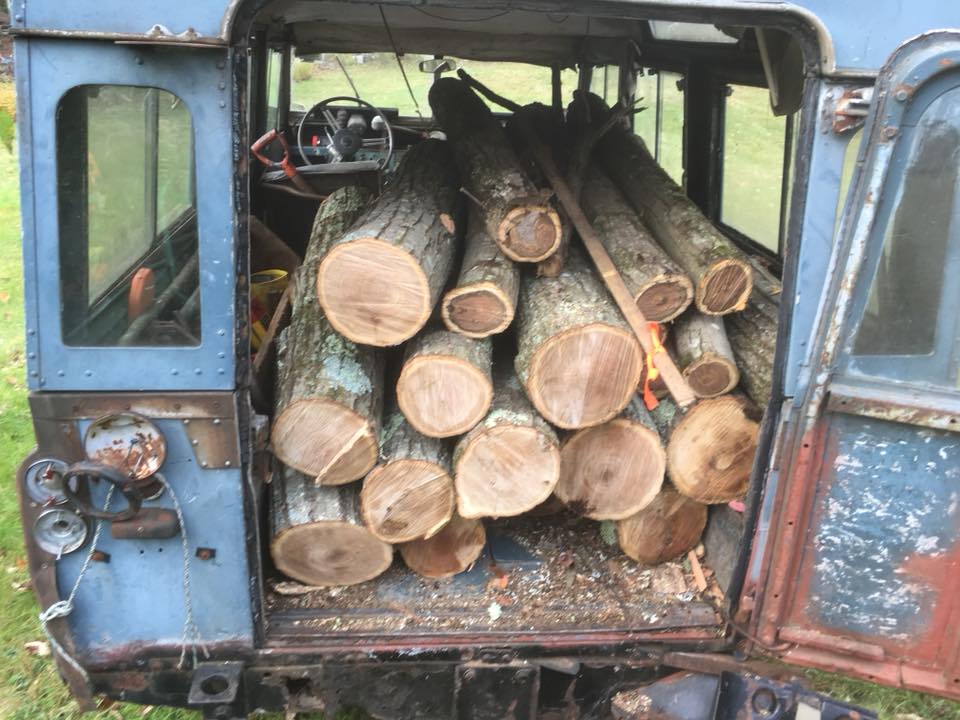
Low stack of Red Oak ready for inoculation.
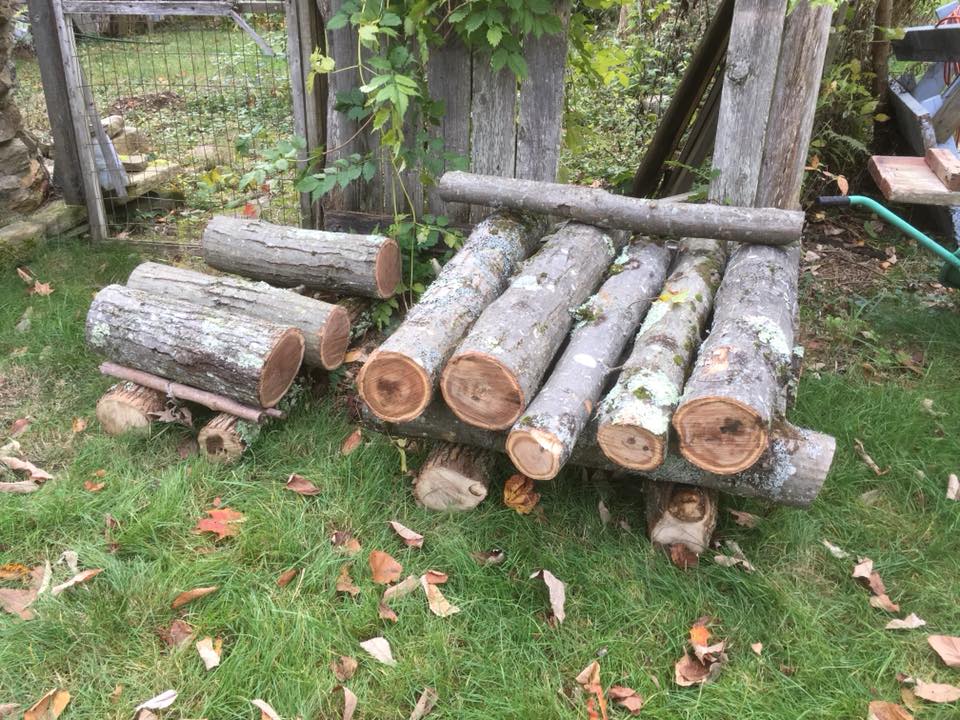
Red Maple ready for inoculation.
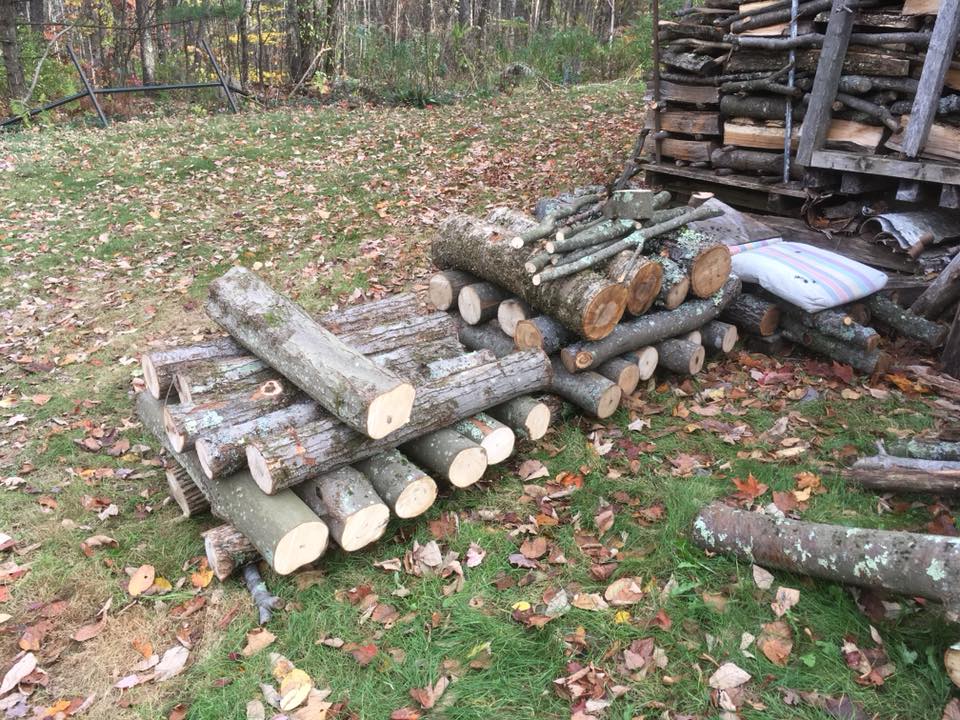
Folks are very welcome to join us and learn about log inoculation and to take home some logs.
If you want to bring logs to inoculate and share that’s fantastic!
If you have trees that would make good Shiitake or Oyster logs and need help cutting and moving them just let me know. We can help!
Transporting logs in my trailer.
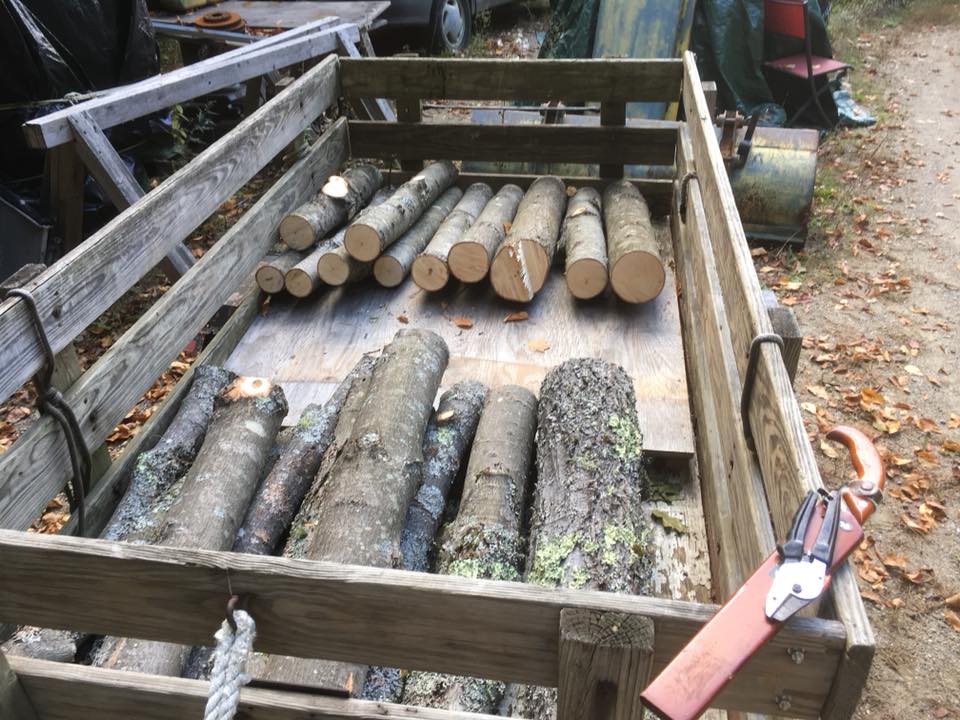
The cash outlay usually runs between $90-120 and we encourage people to contribute what they can and what feels fair.
The first one was Nov 12, 2016 – just after the presidential election. I think everybody was enjoying doing something optimistic together.
We usually start around 10-11, have a pot luck lunch around 1, and finish around 3-4.
Cut live logs at least two weeks before inoculation.
It’s important to use trees that have a great deal of stored food energy. It’s this stored food energy that the mushroom mycelium processes and uses to intermittently create fruiting bodies to spread spores. While most of the mushroom exists in the form of a web of mycelium growing throughout the log the visible fruiting bodies are what we pick and what everybody refers to as mushrooms.
Deciduous trees have the least food energy in the late Spring and early summer. They have used up a bunch of energy creating and growing lots of green leaves and it’s these leaves which are creating energy for the tree the rest of the sumer and into the Fall. When the leaves have turned color in the Fall the tree is no longer making and storing additional food energy. This is a great time to cut trees for mushroom inoculation. Around here that is usually in mid to late October.
Mushroom logs need to be moved around and re-positioned occasionally so it’s helpful to make sure they aren’t too big and end up annoyingly heavy. A good size to cut are logs with diameters from 3-6 inches and lengths from 28 to 36-40 inches. This usually means that a tree that is 8 inches in diameter at the base is terrific.
After cutting, the logs need to rest for two or three weeks before inoculation. A healthy tree has anti-fungal properties and it important to let these properties dissipate before introducing the mushroom mycelium we want to grow in the log.
After cutting, the logs should be placed in low stacks just above the ground and protected from drying out excessively. If they end up stacked where it’s sunny cover them with something to lessen the tendency to dry out. Take the covers off it it rains.
Another good time to cut logs is in the early Spring before the buds swell. Around here that usually means mid-March. As this point the tree still hasn’t used much of the food energy stored last season.
Logs for growing Shiitakes.
White Oak seems to be one of the very best trees for growing Shiitakes, Red Oak is fine also. We’ve also grown them on Red Maple and Beech.
Shiitakes always seem happy on White Oak.
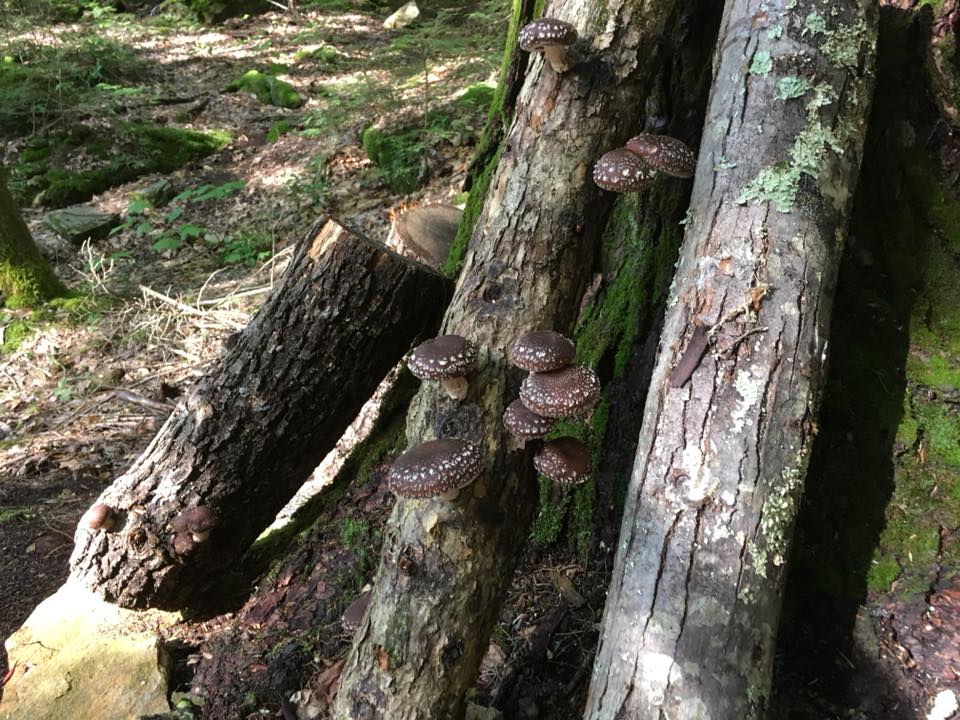
See this species selection table: Tree Species Chart.pdf
Logs for growing Oysters.
Oyster mushrooms like to grow on some of the softer hardwoods. Any of these species should work well:
- Bigtooth Aspen (Populus grandidentata)
- Trembling Aspen (Populus tremuloides)
- Cottonwood (P. deltoides and other spp.)
- Balsam Poplar (P. balsamifera and other spp.)
- Basswood
- Hackberry and Mulberry
- Willows (Salix spp.)
- Tulip or Yellow Poplar (Liriodendron tulipifera)
I’ve also seen uncultivated Oysters growing well on Sugar Maple and Beech logs.
Pohu Oyster mushrooms growing on an Aspen log.
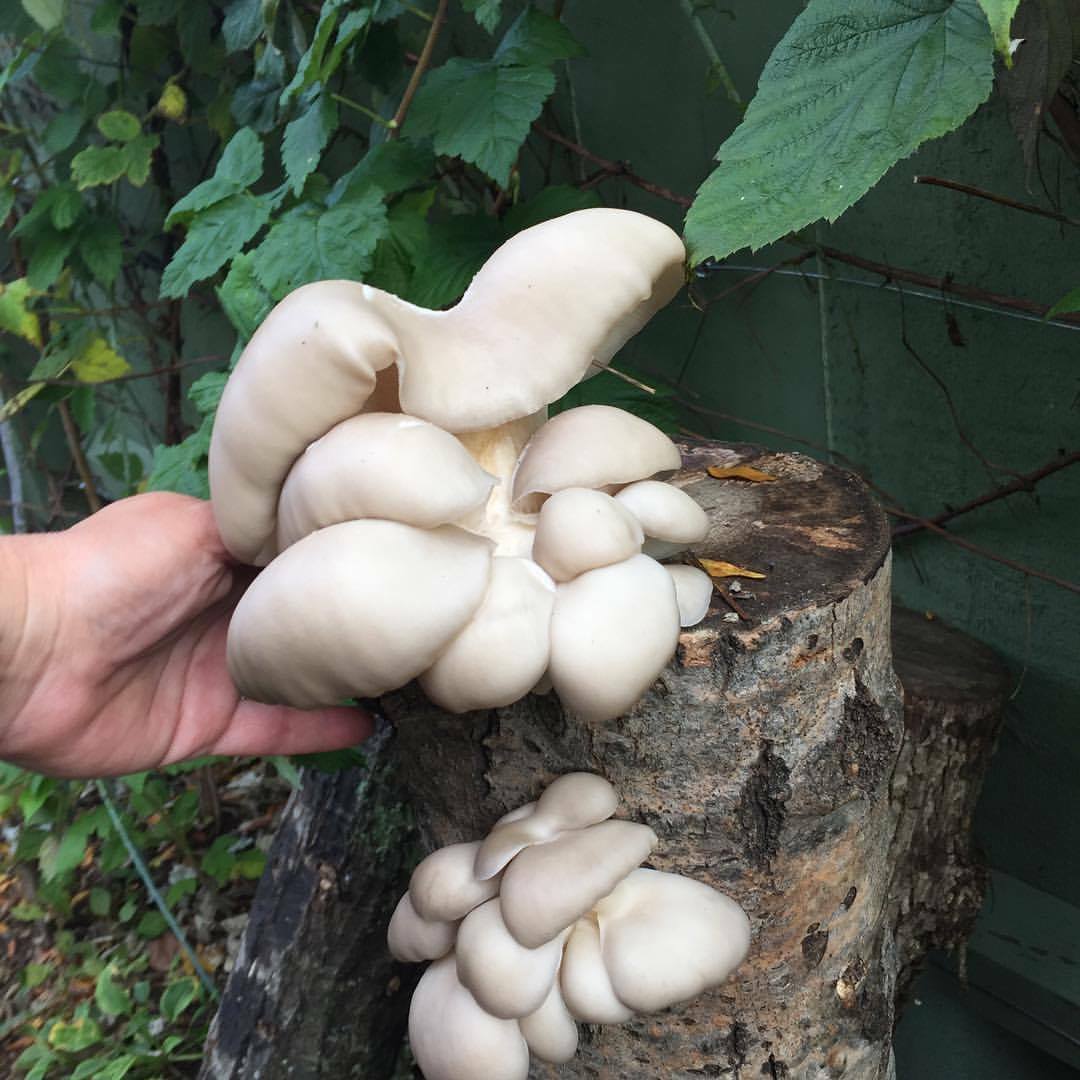
After inoculation it usually takes about a year before before first fruiting.
After inoculation the logs will usually need a full growing season before the mycelium has built up enough energy to start a first fruiting. Mycelium grows best when the weather is warmer and the logs stay relatively moist.
During this initial period keep the logs in low stacks just off the ground and someplace where they get little direct sunlight.
- Low stacks close to the ground help keep the logs moister because the microclimate next to the ground is a bit more humid.
- Once established if the log drys out the mycelium won’t die – it will just stop growing. You’ll get mushrooms sooner if the logs are kept relatively moist.
If you inoculated in the Fall or Spring and the summer has been warm and there were regular soaking rains it’s reasonable to expect a first fruiting to happen in the Fall. When you think the logs might be getting ready to fruit stand them up and lean them against a tree or fence.
There are two problems to be aware of if the mushrooms start to fruit while the logs are in a low stack.
- You might not see them if they start growing on the bottom of the log.
- Some will end up growing into the side of the log next in the stack and end up mishapen.
It will be both easier to see and pick mushrooms that are fruiting when the logs are almost upright and leaning against something.
Shiitake mycelium appear to still grow throughout a log even when other fungi are also colonizing the log – however it’s good to avoid introducing other fungi.
I’ve started placing flat rocks around the trees I lean the logs on so the bottom of the log is not in contact with the ground.
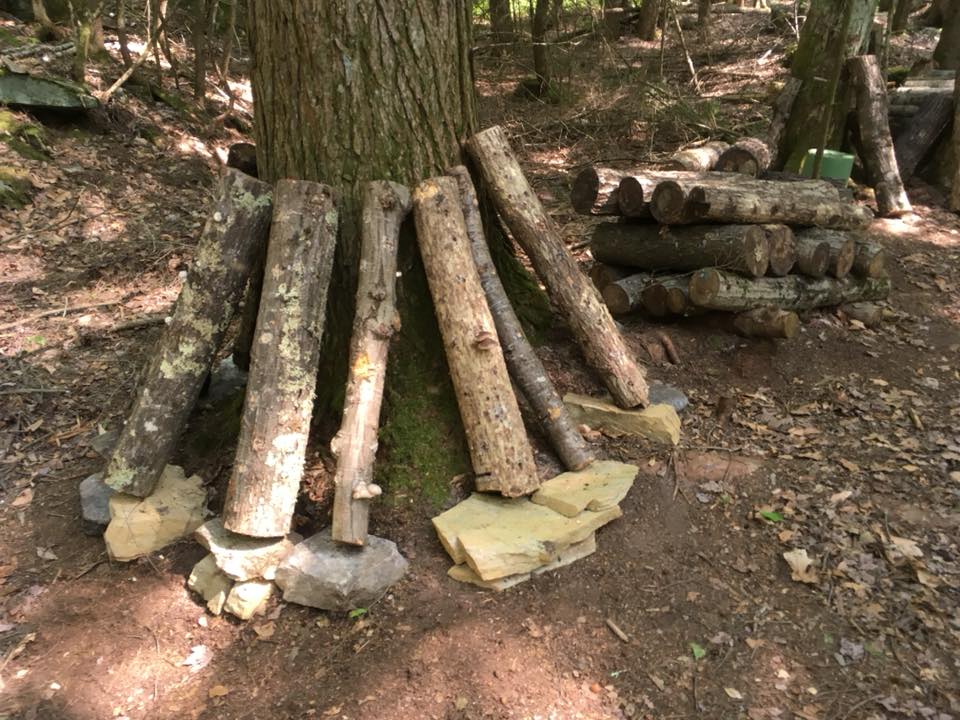
Signs the mycelium is growing well in the first year after inoculation.
Mushroom spawn is made by growing a specific strain of mycelium in a sterile sawdust medium. We usually buy spawn in 5 pound bags just before the inoculation party.
When spawn is first put into drilled holes and covered with wax it appears to be a medium-light brown color.
The color of the spawn under the wax will change to white in about two weeks of warm weather and sufficient moisture. The change to white is the first indication of mycelium growing happiness.
After another four weeks of good mycelium growing conditions white spots of mycelium growth will appear at ends of the logs.
The first spots will appear lined up with the inoculation holes closest to that end. Most of the cells in a log are oriented longitudinally and this cell orientation makes growth in that direction easier.
First visible spots of Shiitake mycelium just after appearing on end of log.
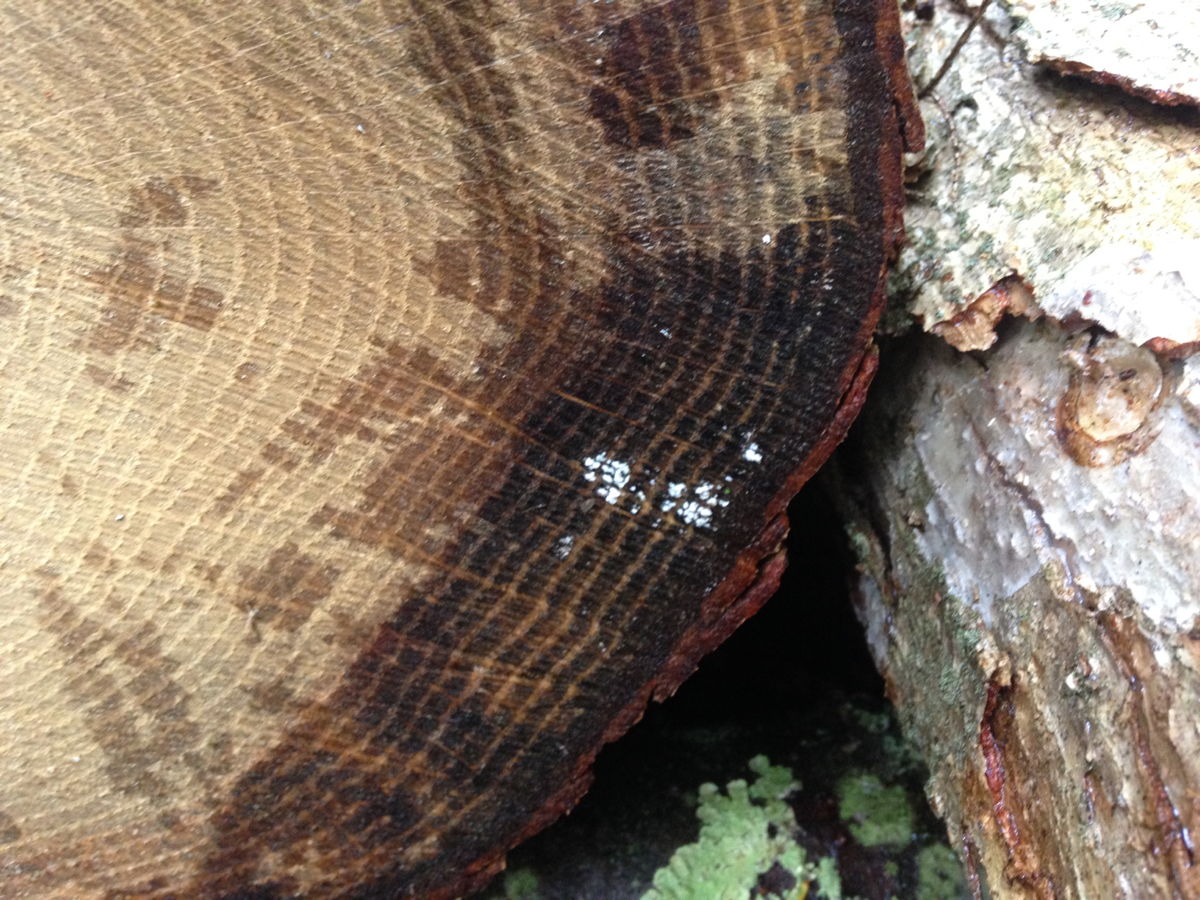
After another couple of months the white spots of mycelium on the ends of the logs will be getting much larger.
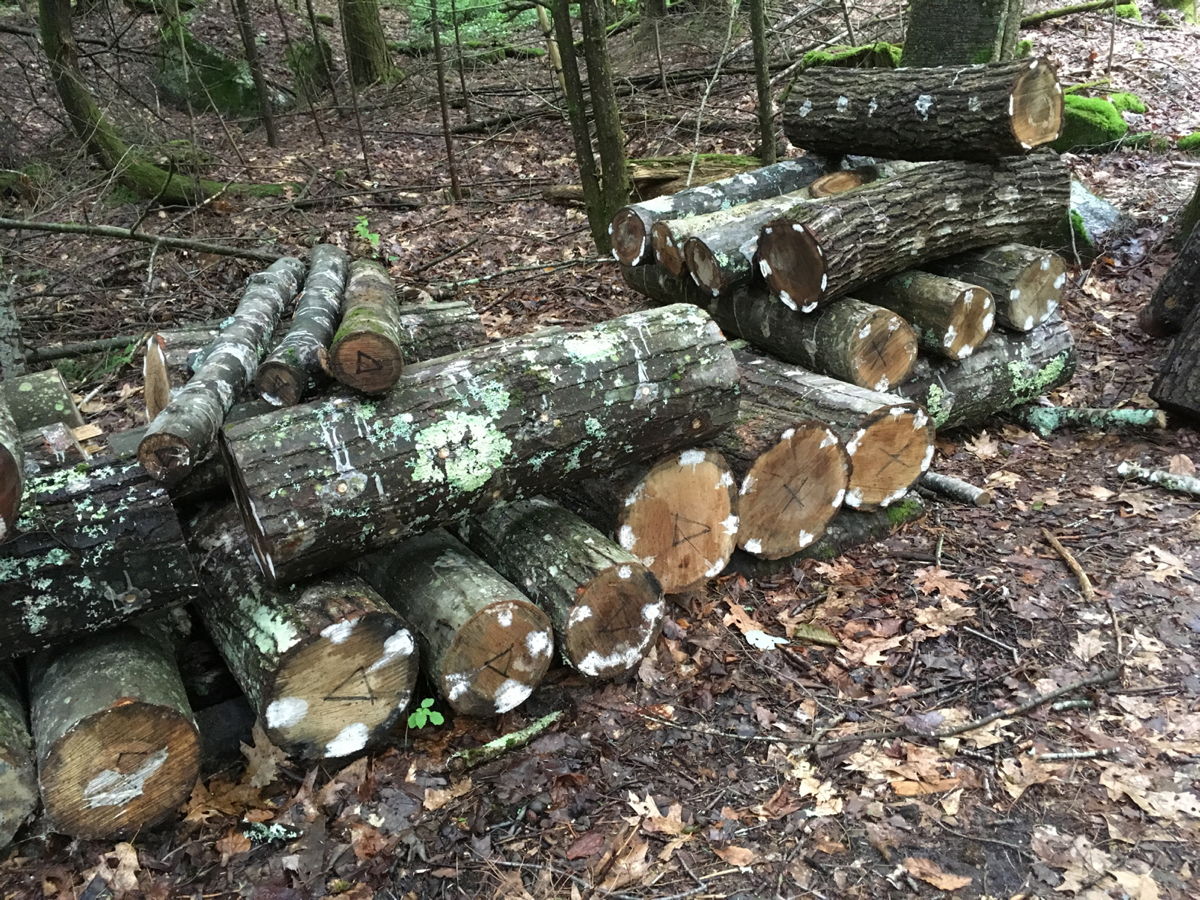
It’s important to keep your logs someplace you’ll visit often.
When the mycelium in the logs starts a fruiting it usually only takes about 5-7 days for a tiny button poking through the bark to grow into a full-sized mushroom! If you have your logs deep in the woods and you only get to visit once every 3-4 weeks you could miss a fruiting entirely!
This is how fast a little Shiitake grows over just four days!
It’s helpful to be able to water your logs if the weather ends up hot and dry and there is no rain for several weeks.
What can you expect during the second and subsequent years after inoculation?
In the second year you can expect some logs to have larger fruitings with many mushrooms.
Here’s a log that I picked over 40 mushrooms from in one fruiting.
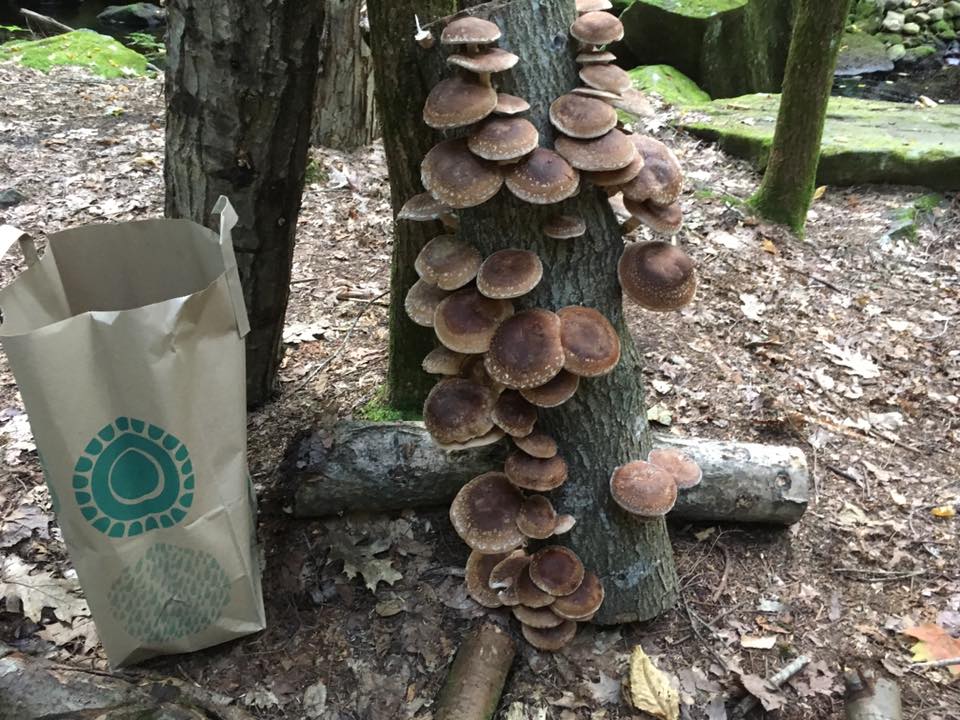
This level of abundance is unusual. Normally I might get 5-10 mushrooms on a single log in a fruiting.
Normally Shiitake logs will produce significant numbers of mushrooms for at least 3-5 years.
After a log has fruited when will it fruit again?
I’ll often get three fruiting from a mature log during warmer periods from spring to fall.
After a log has fruited the mycelium has to first build up reserves of biological energy before a subsequent fruiting might kick off. This usually means at least 7-8 weeks of good mycelium growing weather: relatively warm and regular soaking rains (or the equivalent watering). After the mycelium has processed enough of the food energy in the log a number of different environmental triggers might contribute to the start of a fruiting such as large changes in moisture or temperature as might occur in a cold soaking rain. Physical shock can also contribute to the conditions which trigger a fruiting. If you aren’t specifically forcing a log to fruit you will want to check regularly to see if a fruiting has started especially after a long cold rain. As the weather gets colder the growth of mycelium in a log slows.
If there is no rain for several weeks and the weather conditions are dry the logs will start to dry out. As a log gets dryer the growth of the mycelium will also slow. if the log gets dry enough the mycelium will enter into a form of stasis and won’t start growing again until moisture levels in the log rise again.
In very dry conditions I’ve regularly watered my logs every four or five days to emulate the effect of a soaking rain.
Forcing a log to fruit
After a log has fruited for the first time and then after the mycelium has grown and stored enough new energy reserves you can encourage a log to start a fruiting by exposing it to a temperature and moisture shock.
My logs are stacked next to a cold steam with regular flow so I just throw them into the stream for a day. I have to be a bit careful to to soak the logs when there might be a heavy rain or the logs can get washed down stream.
After a long period of heavy stream flow when I couldn’t soak any logs I made a boom out of rope and chunks of Black Birch to use when I need to keep the soaking logs from washing downstream.
Using a temporary homemade boom to keep logs from floating away in periods of high flow.
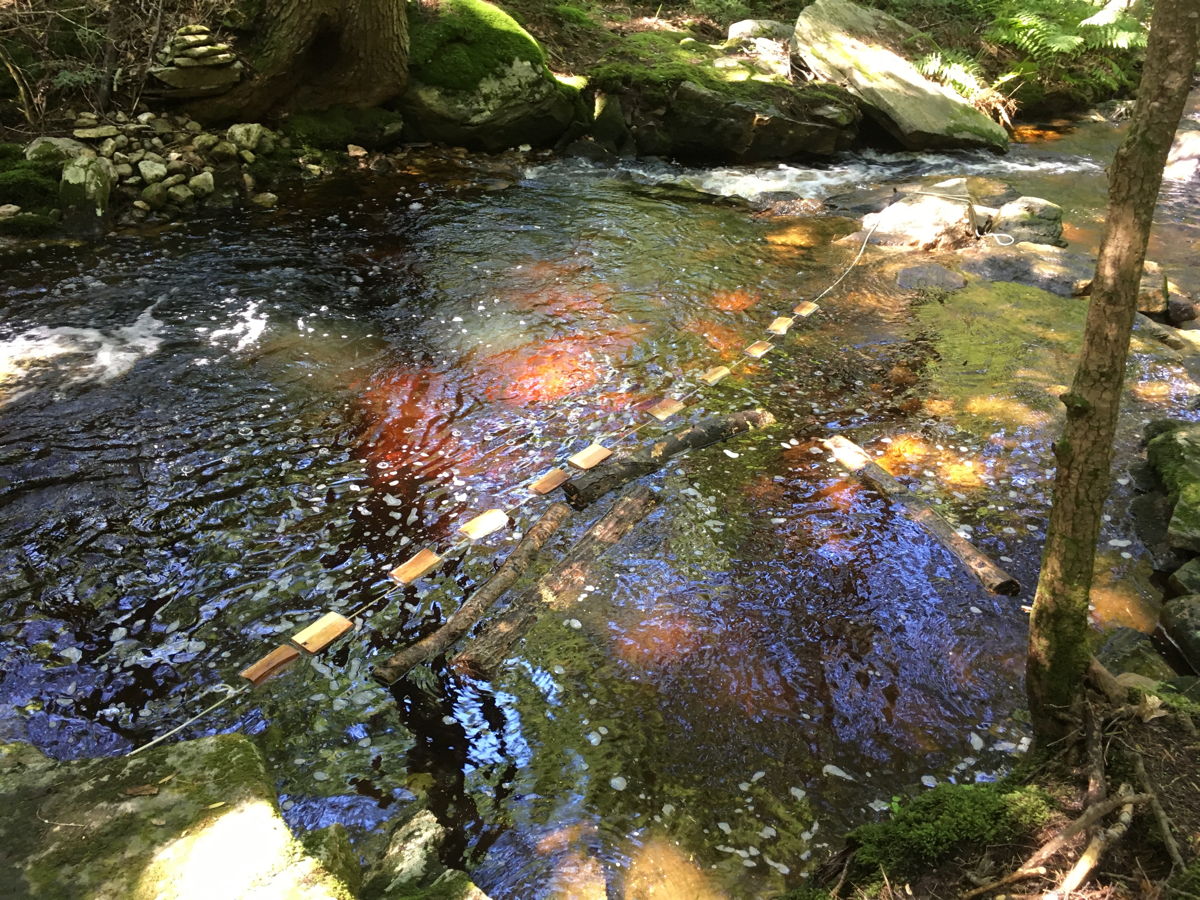
Before I made the boom I sometimes had logs go on a trip. They might be found if they haven’t traveled too far!
Finding a Shiitake log that had floated downstream after a heavy rain.

If you don’t have a stream you can use a stock tank or even a large trash can. The fruiting response of the mycelium is enhanced if the water is much colder than the air temperature. This will be true just after a soaking tank is filled with water that is basically ground temperature. After just a day or two the water will be close to the existing average air temperature and will need to be emptied and refilled to get more cold water.
If the mycelium was ready to fruit you will have a new crop of mushrooms ready to pick in about a week.
Drying Shiitakes.
Dried Shiitakes keep for months if you store them in a light and air-tight container.
I’ve used a small food dehydrator. Drying outside on a screen in sunny dry conditions works well too!
A good harvest … and an abundance that makes the food dehydrator very useful.
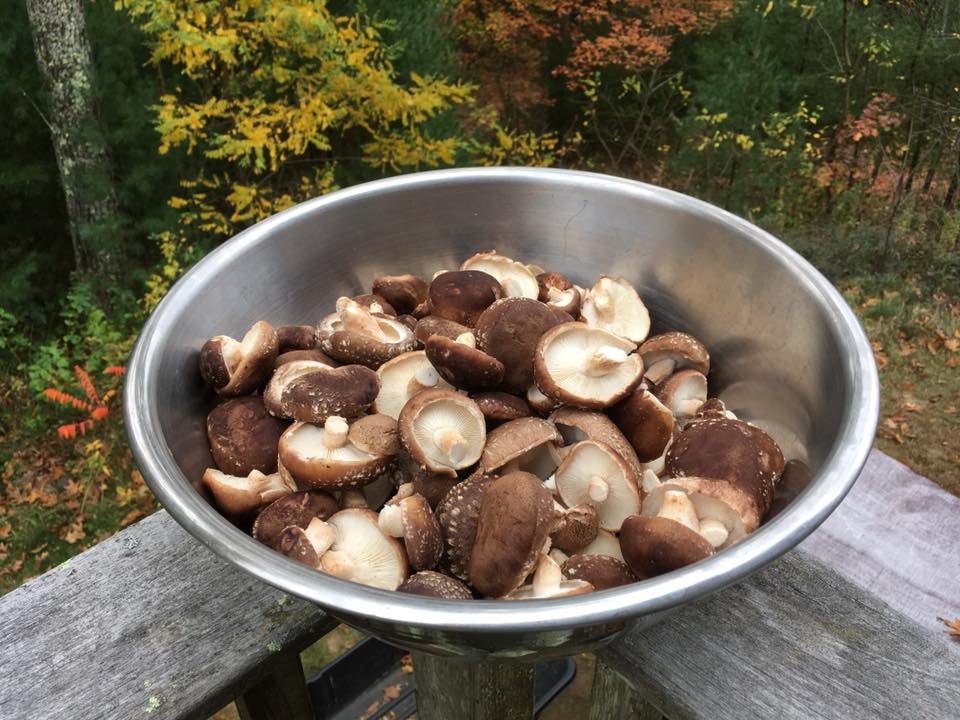
Whole dried Shiitakes.
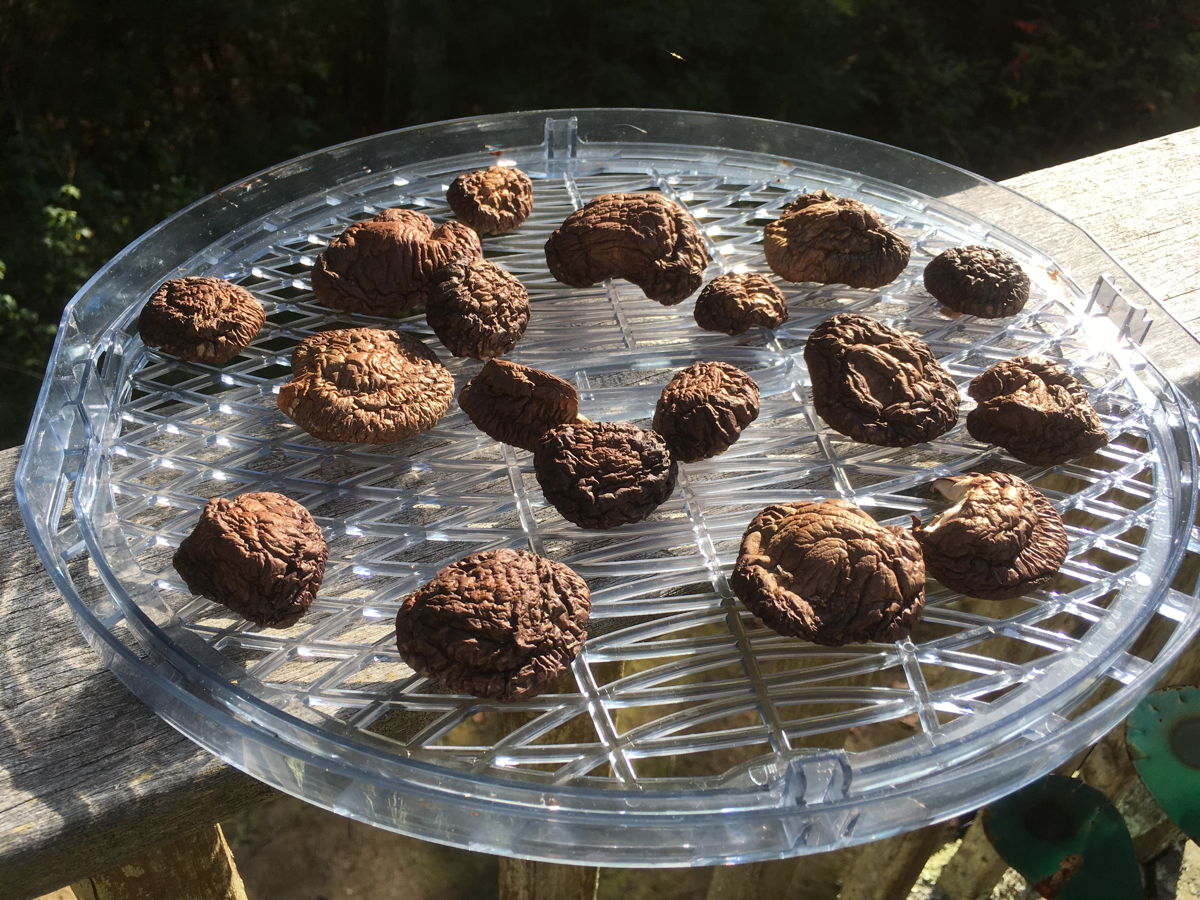
Tools and supplies.
We’ve been buying our supplies from fieldforest.net.
- Mushroom Spawn: this is mycelium that has been grown on sterile sawdust. We buy five pound bags for $25-30.
- Cheese wax. This is heated and used to seal the holes filled with mycelium spawn as well as to seal injuries in the bark of the log. We usually buy 10 pound blocks for about $30.
- Special drill bit that works in an angle grinder. This bit make drilling just the right holes very fast, accurate and easy. Have needed to replace after about 500 logs. Cost $14.
- Angle grinder for use with the special drill bit along with a $35 angle grinder adaptor for special drill bit. Haven’t had to replace this yet.
- Brass inoculation tool for stuffing drilled holes with spawn.
- Hot plate and pan for melting the cheese wax along with foam brushes for applying the wax.
- Extra catalogs and copies of the excellent species-specific pamphlets Field and Forest supply with their spawn.
Supplies and tools for an inoculation party.
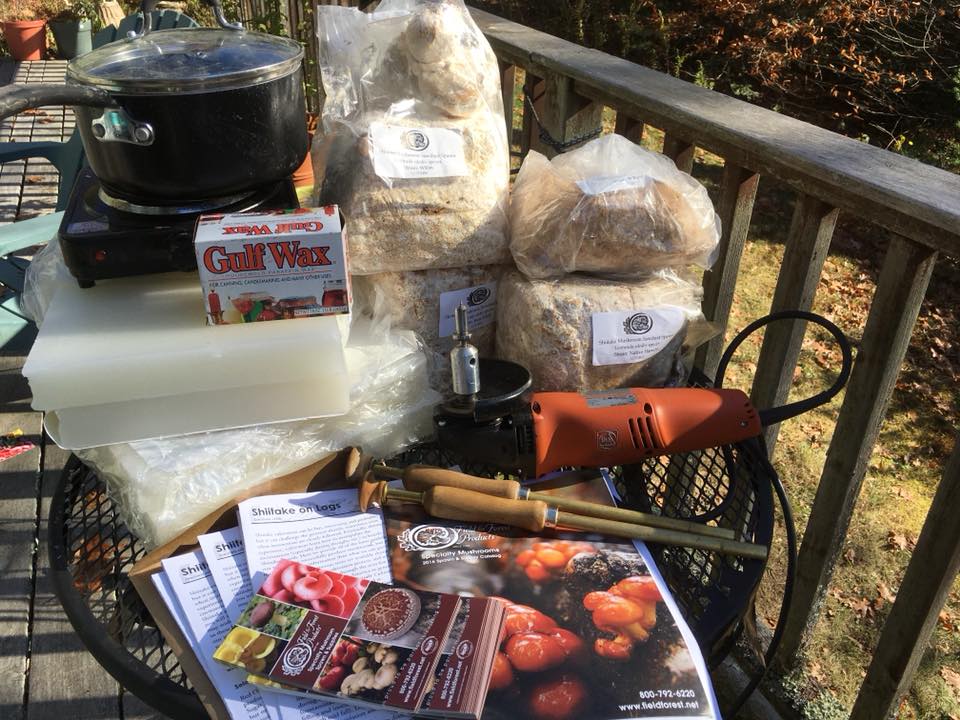
Mushroom strains we have tried.
Wide range Shiitake strains.
WR46 shiitake mushrooms.
These grow well and some have the most amazing textured caps!
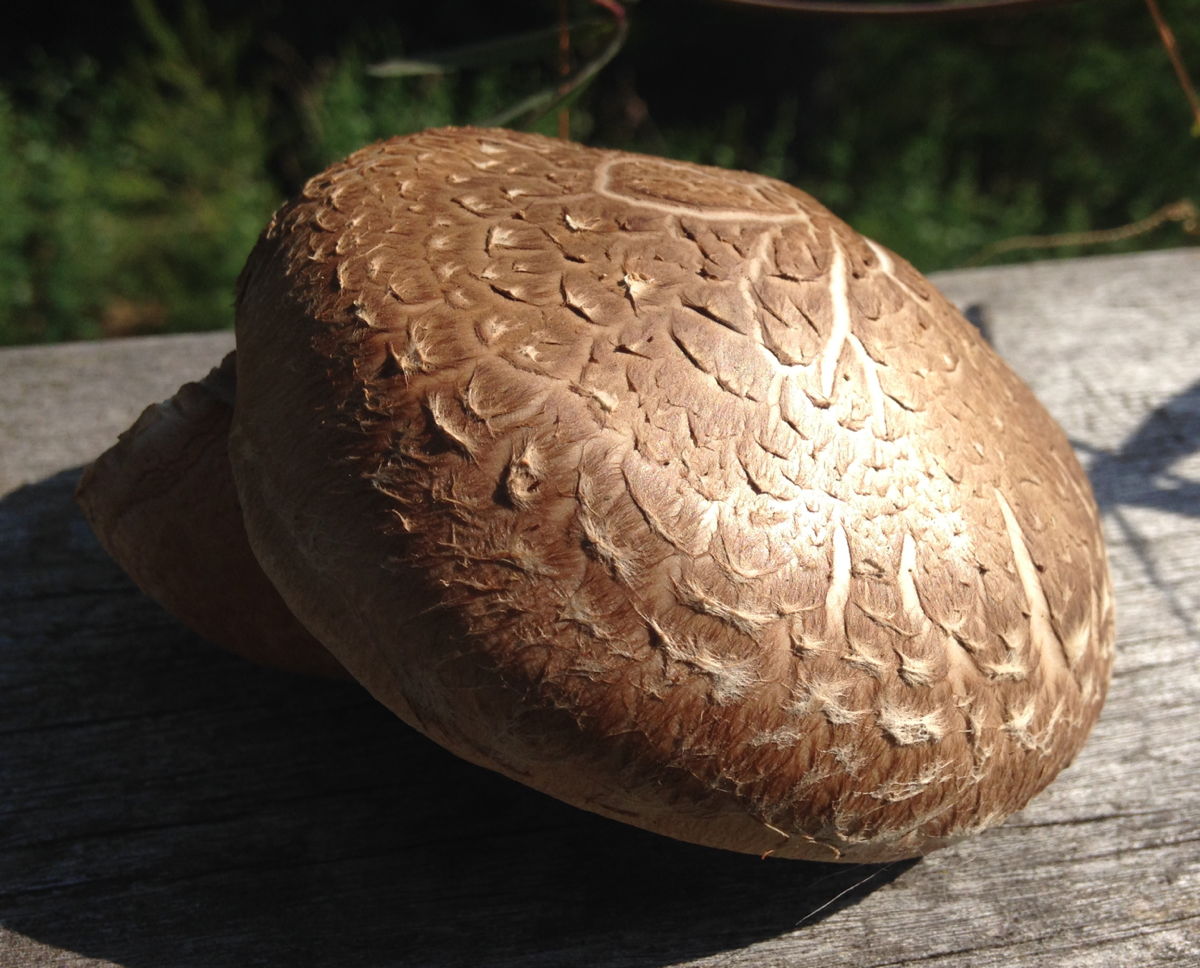
WR46 description from Field and Forest:
WR46 is a wide-range strain that will fruit from Spring through Fall. The mycelium develops relatively quickly (6-9 months at 75 degrees until first fruiting and the logs recover quickly after the fruiting.
West Wind shiitake mushrooms.
Red Oak is quite abundant around here so we have tried this strain also.
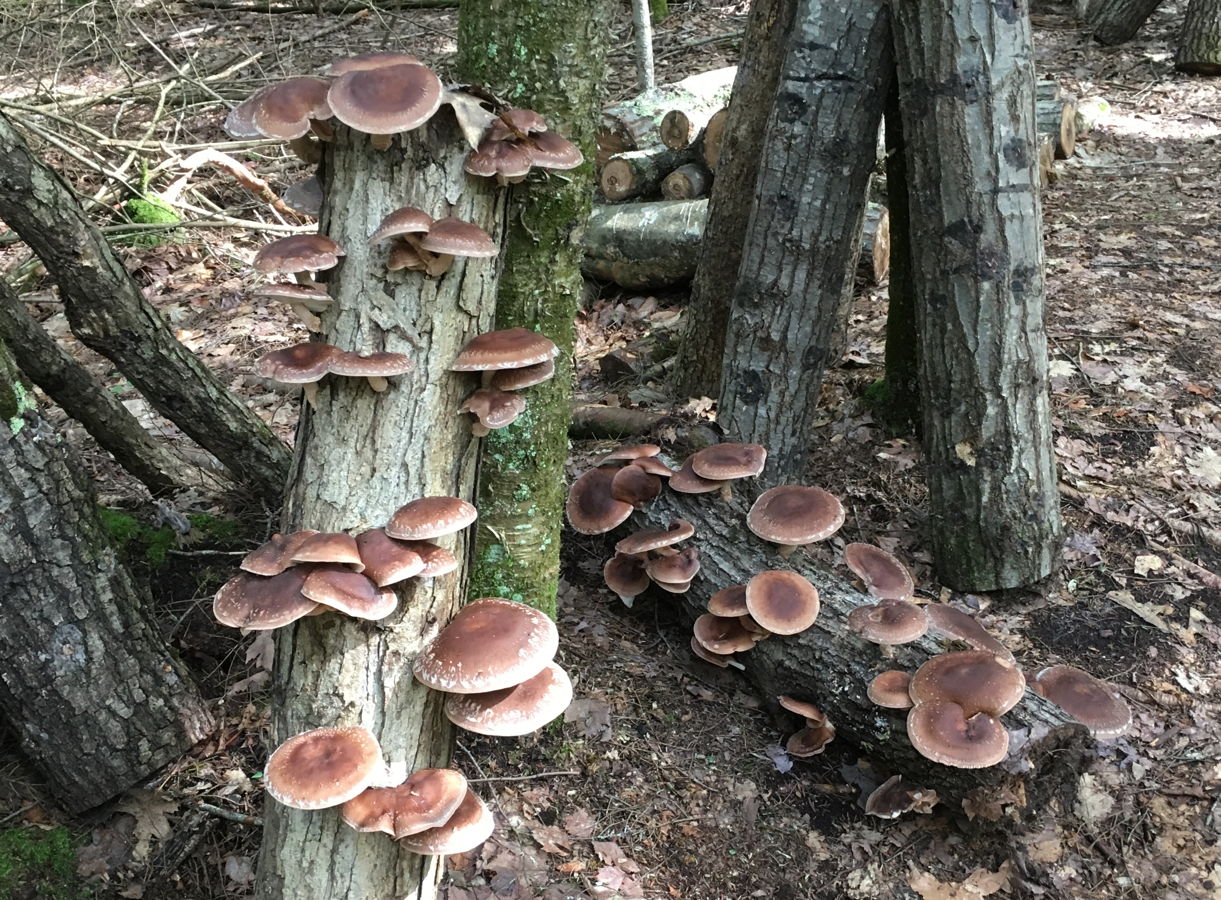
West Wind description from Field and Forest:
West Wind features a fast spawn run, large, thick, first flush mushrooms, and heavy yields, making it a great strain choice for new growers. West Wind is also slightly more drought tolerant than other WR strains, and shows a slight preference for red oak over white oak. Fruits naturally in the spring and fall.
Beltane shiitake mushrooms.
Beltane has a darker cap and were quite large in this fruiting.
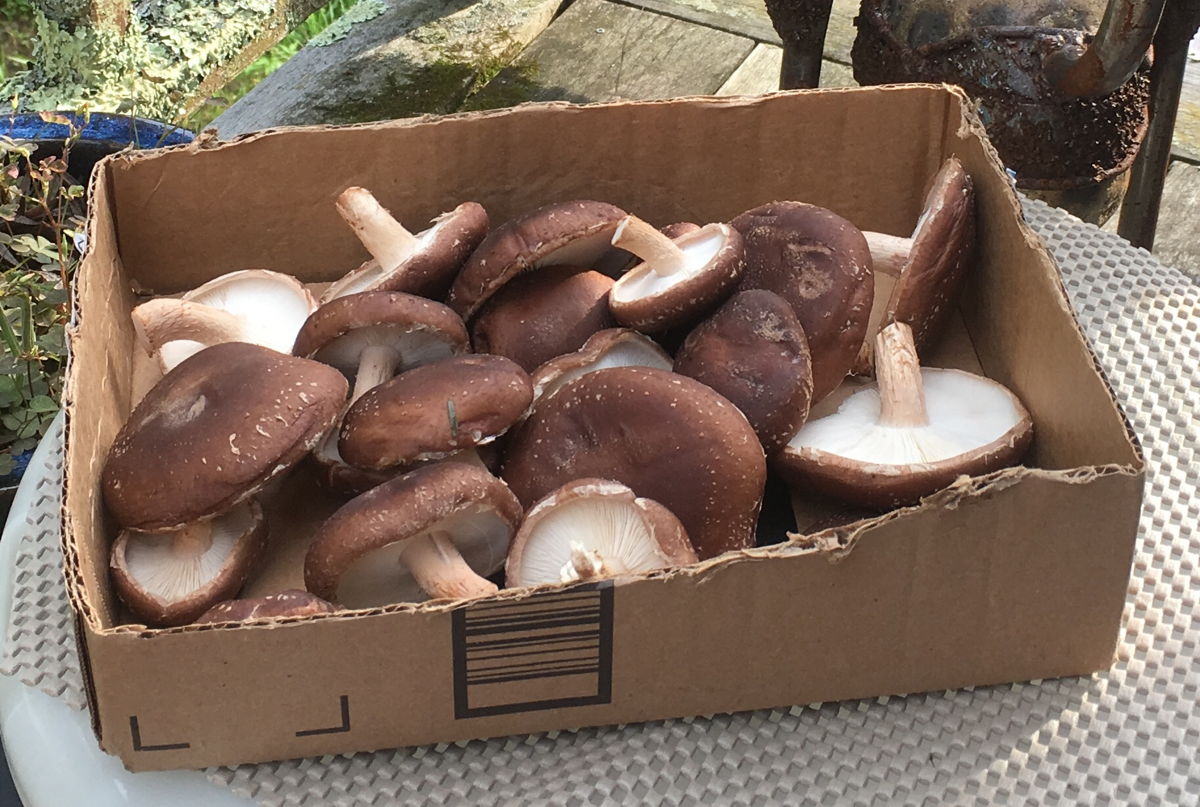
Beltane description from Field and Forest:
Beltane is named after the Celtic May Day, which celebrates the return of vitality to the growing season. This new strain prefers May weather for the heaviest seasonal fruiting, but produces quality mushrooms mid-summer in a cool, shaded woods after dunking in cold water. Firm, caramel-colored caps dusted with white fibrils darken to cocoa brown as caps flatten. Fruiting temp ranges from 54-75° F.
Native Harvest shiitake mushrooms.
Red Maple is also abundant locally and Native Harvest is reported to grow well on it.
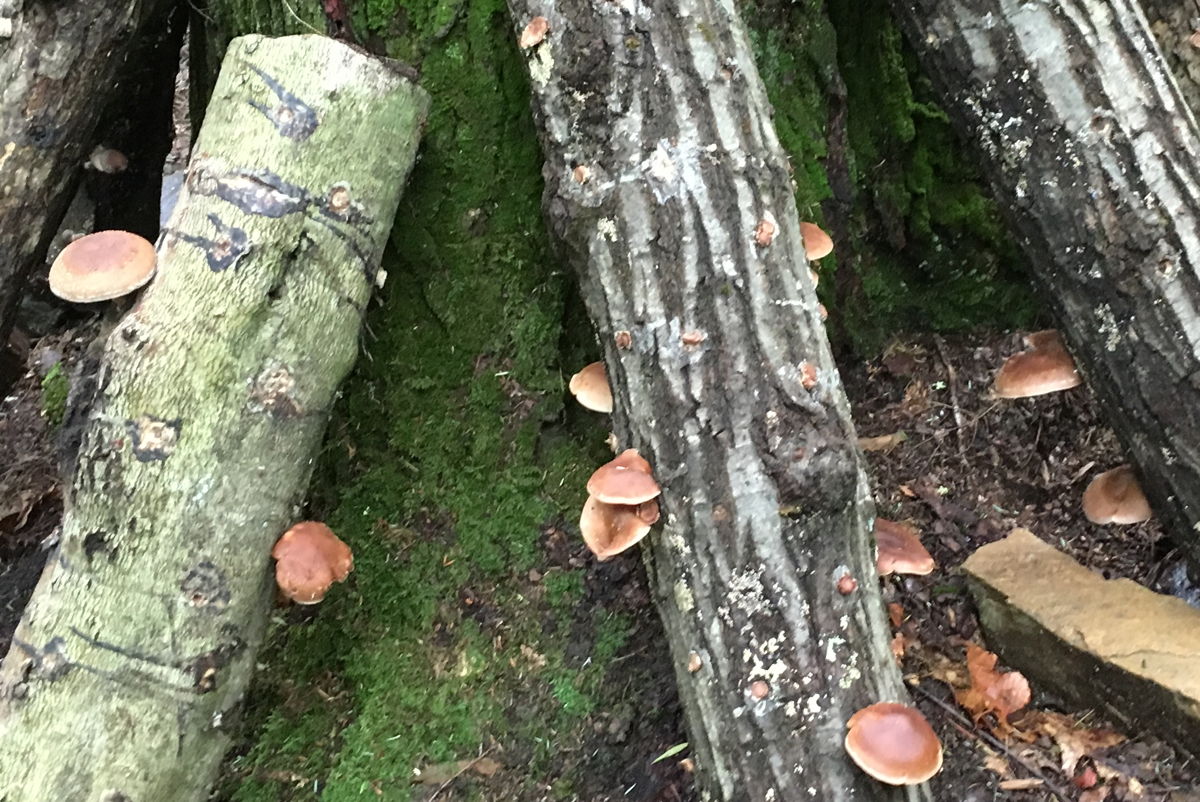
Native Harvest description from Field and Forest:
We naturalized Native Harvest on our farm several years ago, this strain has been tested from North to South and the results are the same: a very fast, vigorous strain with excellent quality. First found on oak, it is also a good producer on Red Maple. Unlike other wide range species, Native Harvest™ also gives a late fall flush; an added bonus for the Thanksgiving table! Spawn run is 6 to 12 months.
Warm weather Shiitake strains.
Night Velvet shiitake mushrooms.
I like how dark the Night Velvet caps are.
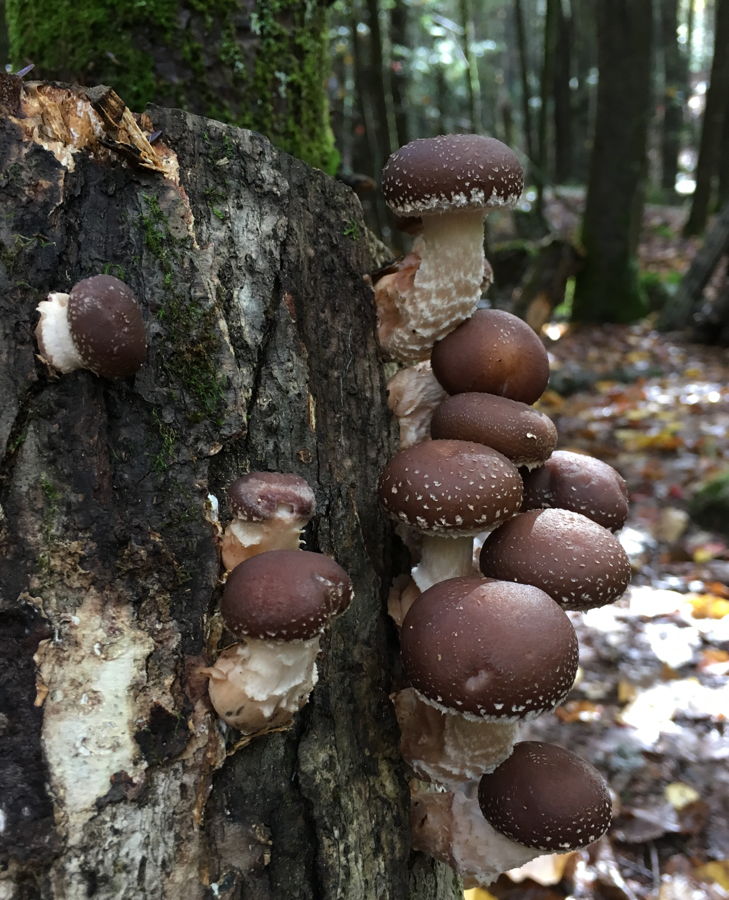
Night Velvet description from Field and Forest:
Night Velvet is a warm weather strain (that behaves more like a wide-range strain) that will fruit from mid-Spring to early-Fall. Typically the mycelium will take 9-12 months at 75 degrees to develop before the first fruitings. After the first fruiting both strains will respond well to “forcing” a fruiting by soaking the logs for a day in cold water.
Oyster strains.
PoHu oyster mushrooms.
We’ve had good Fall and Spring fruitings from PoHu oyster mushrooms.
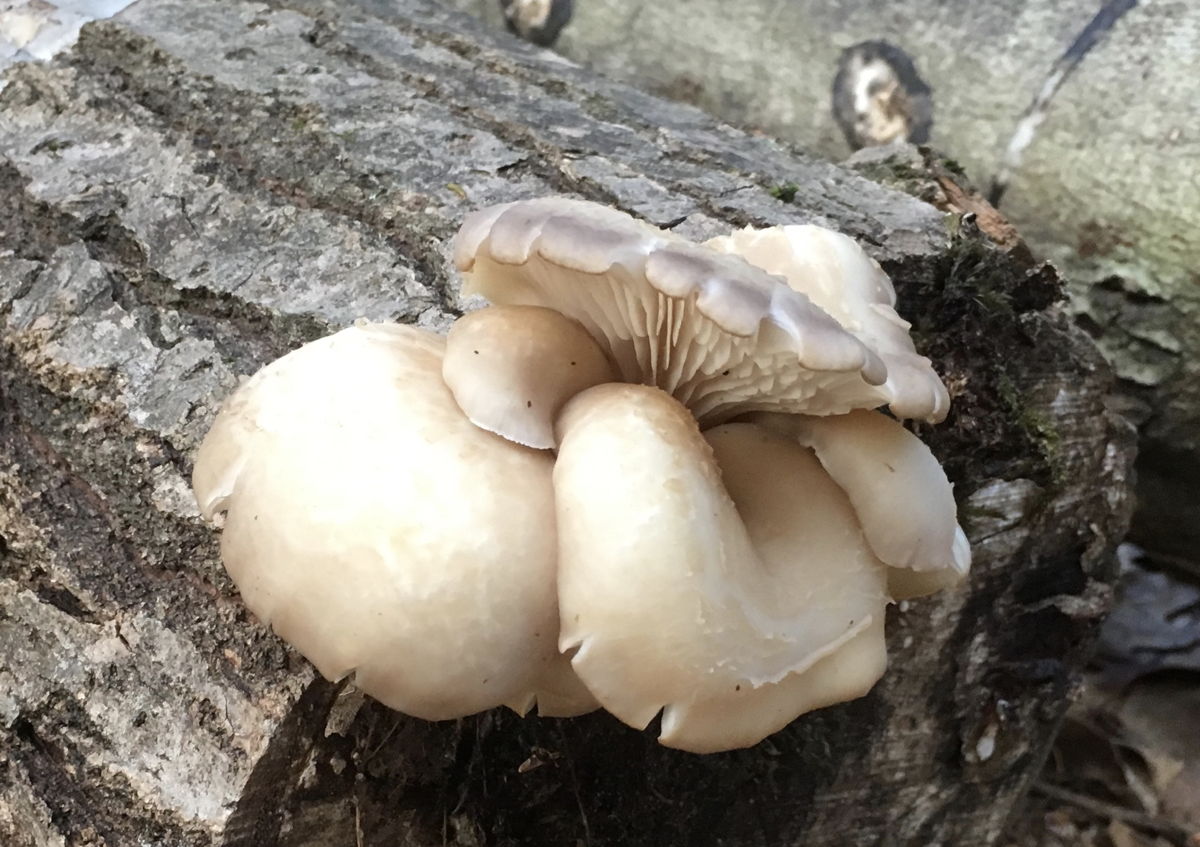
PoHu description from Field and Forest:
The PoHu oyster strain is the most “wide range” of all our Oyster strains. Expect multiple fruitings throughout the growing season, including summer. PoHu is a heavy producer and grows many ocher to white colored mushrooms in thick clusters, perfect for farm markets and hungry homegrowers.
Kira oyster mushrooms.
Oct 9 2018: I think these are Kira Oyster mushrooms just starting on a bigtooth aspen (Populus grandidentata) log.
Kira oysters just starting to bud on bigtooth aspen log
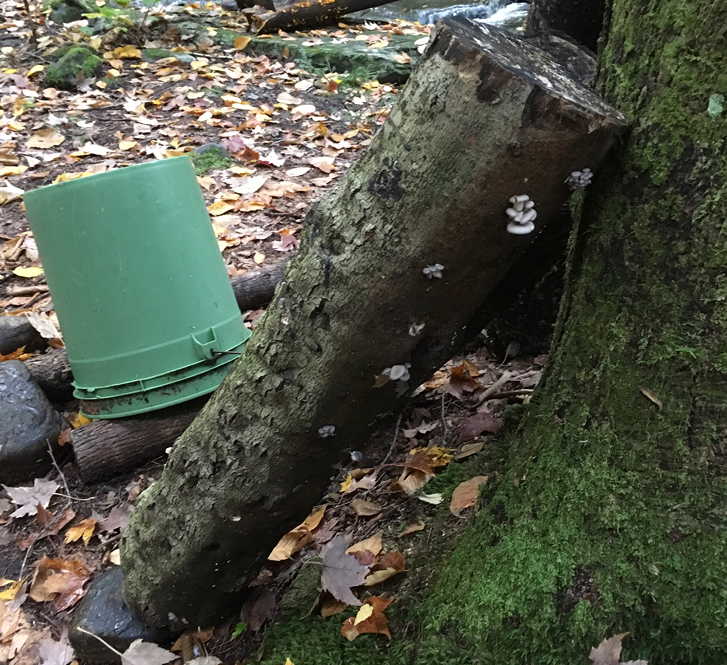
Kira oysters closeups
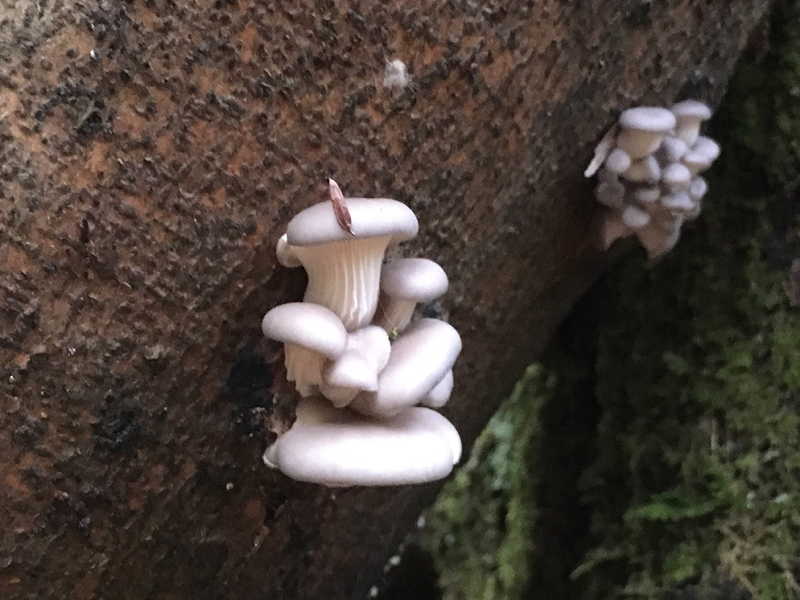
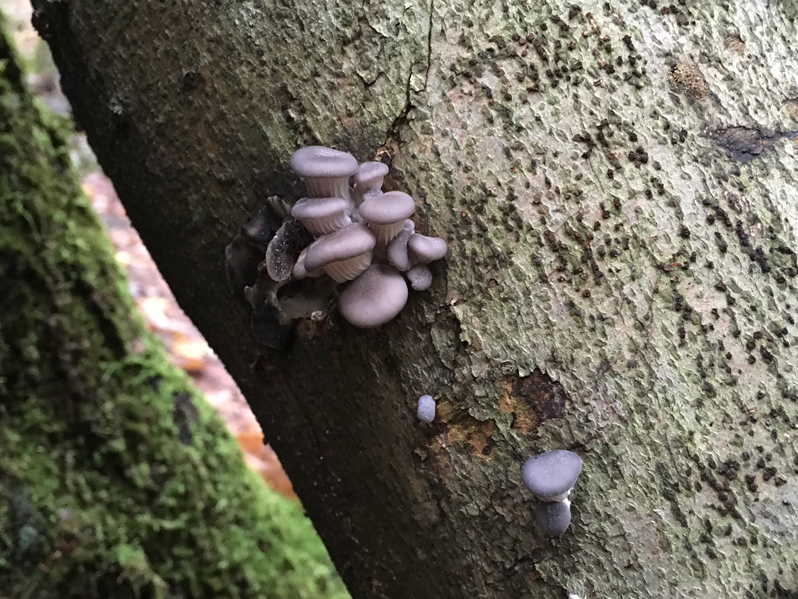
Kira description from Field and Forest:
The Kira oyster’s color moves from blue gray to nearly white, finishing with large dusky clusters of savory oysters. The hallmark of this strain is its ability to adapt to a wide range of wood types with multiple fruitings across the season. Most fruiting for this oyster occurs in the spring and fall, with a fruiting temp range of 40-60° F. Kira is like a cool weather version of PoHu with its prolific nature, and at F&FP, it’s the beloved oyster of spring.
Lions Mane mushrooms.
Fall 2017 Kathy Becker brought Beech logs and Lions Mane in plug form to share. She reports that we should expect the initial mycelium growth before first fruiting to take about two years.